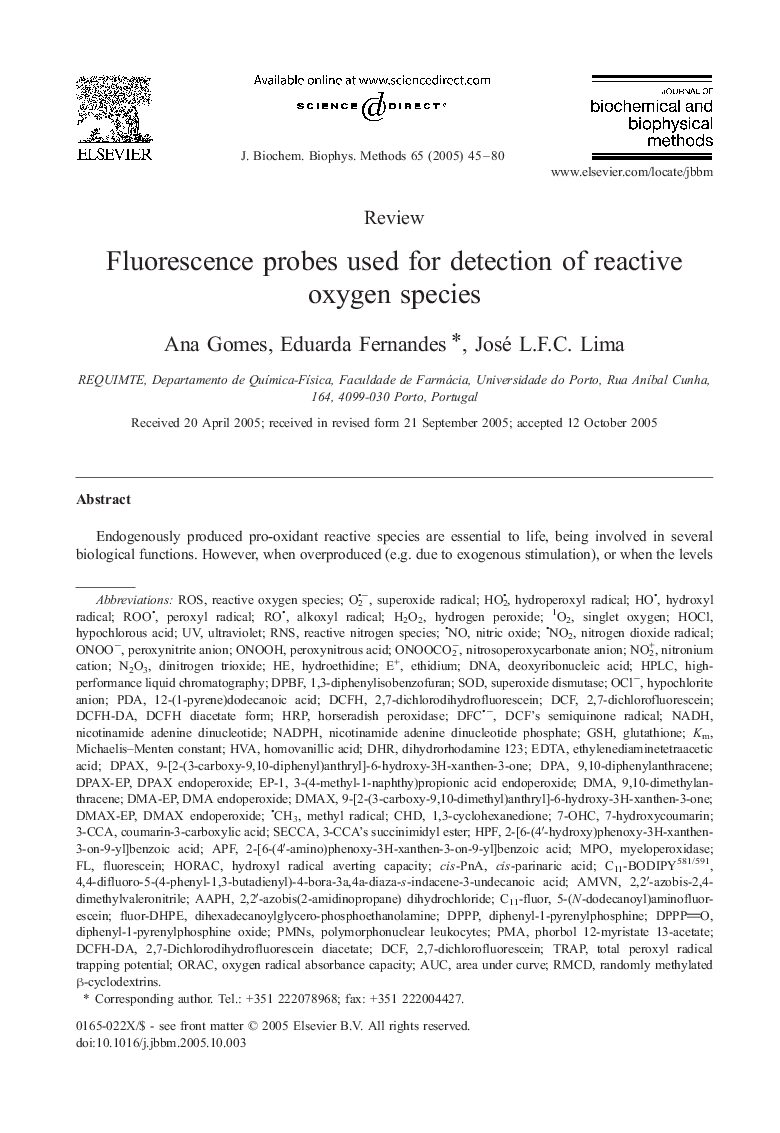| Article ID | Journal | Published Year | Pages | File Type |
|---|---|---|---|---|
| 9891227 | Journal of Biochemical and Biophysical Methods | 2005 | 36 Pages |
Abstract
Endogenously produced pro-oxidant reactive species are essential to life, being involved in several biological functions. However, when overproduced (e.g. due to exogenous stimulation), or when the levels of antioxidants become severely depleted, these reactive species become highly harmful, causing oxidative stress through the oxidation of biomolecules, leading to cellular damage that may become irreversible and cause cell death. The scientific research in the field of reactive oxygen species (ROS) associated biological functions and/or deleterious effects is continuously requiring new sensitive and specific tools in order to enable a deeper insight on its action mechanisms. However, reactive species present some characteristics that make them difficult to detect, namely their very short lifetime and the variety of antioxidants existing in vivo, capable of capturing these reactive species. It is, therefore, essential to develop methodologies capable of overcoming this type of obstacles. Fluorescent probes are excellent sensors of ROS due to their high sensitivity, simplicity in data collection, and high spatial resolution in microscopic imaging techniques. Hence, the main goal of the present paper is to review the fluorescence methodologies that have been used for detecting ROS in biological and non-biological media.
Keywords
GSH1,3-Cyclohexanedione1O2Dcf2,7-dichlorodihydrofluorescein2,7-dichlorofluoresceinHOClDPPPNADPHAAPHC11-BODIPY581/591HRPDPBFCHDDmaxDCFHDCFH-DAphorbol 12-myristate 13-acetateRNSPMNsDMAAPFOCl−DPATRAPEP-1•NO2hpf•NODHRN2O3ONOOH7-OHCORAC9,10-DimethylanthraceneAMVNPDA1,3-diphenylisobenzofuran2,2′-azobis(2-amidinopropane) dihydrochloride2,7-dichlorodihydrofluorescein diacetate7-hydroxycoumarin9,10-DiphenylanthraceneAUCMPODNAHO•PMAO2•−ONOO−ROSHydrogen peroxideAntioxidantHypochlorite anionperoxynitrite anionEthidiumEDTAEthylenediaminetetraacetic acidcis-parinaric aciddeoxyribonucleic acidhypochlorous acidPeroxynitrous acidUltravioletSinglet oxygenDinitrogen trioxideOxidative stressMichaelis–Menten constantdihydrorhodamine 123diphenyl-1-pyrenylphosphineAlkoxyl radicalnitrogen dioxide radicalsuperoxide radicalMethyl radicalhydroperoxyl radicalHydroxyl radicalperoxyl radicalFree radicalSODSuperoxide dismutaseoxygen radical absorbance capacityScavenging activityFluoresceinpolymorphonuclear leukocytesarea under curvemyeloperoxidaseNADHNitric oxidenicotinamide adenine dinucleotidenicotinamide adenine dinucleotide phosphatehomovanillic acidHydroethidineH2O2Horseradish peroxidaseFluorescence probeHVAhigh-performance liquid chromatographyHPLCCoumarin-3-carboxylic acidGlutathionereactive nitrogen speciesReactive oxygen species
Related Topics
Life Sciences
Biochemistry, Genetics and Molecular Biology
Biochemistry
Authors
Ana Gomes, Eduarda Fernandes, José L.F.C. Lima,
